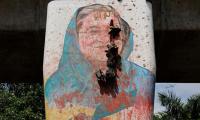Coronavirus, which hit the Chinese central city of Wuhan on the eve of the Lunar New Year, is a flu-like virus. The virus spreads in droplets from coughs and sneezes and has an incubation period of up to 14 days. While China has since moved to lock down most of Hubei province, which has a population around the same as Italy, the virus has still spread to more than a dozen countries from France to the United States. To date, four cases have been reported in Pakistan but there may be more.
China, with nearly 1.4 billion people, is the most populous nation on Earth, and it has taken extreme measures to try to stop the disease, when the first cases were reported in Wuhan, a city of 11 million. The Chinese government has stopped travel in and out of that city and surrounding ones, effectively locking down tens of millions of people. This came as a blow because the people were departing to be home for the Chinese Lunar New Year celebrations which is equivalent to Eid celebrations in Pakistan when everyone tries to reach home and spend the holidays with near and dear ones.
Various countries outside China are taking preventive measures. Australians flown home from Wuhan, China, have been quarantined on an island for two weeks. Americans, also evacuated from Wuhan, will be “temporarily housed” on an air base in California. And in South Korea, the police have been empowered to detain people who refuse to be quarantined.
For countries outside China, the time to prevent an epidemic is now, when cases are few and can be isolated. They are trying to seize the moment to protect themselves against the coronavirus outbreak, which has reached every province in China, sickening more than 7,700 people and killing 170.
The coronavirus is a fresh development and very little was known about it so whether this virus can be contained depends on factors still unknown, like just how contagious it is and when in the course of the infection the virus starts to spread.
Efforts are on to find a cure as well as develop a protective vaccine. A laboratory in China has already successfully grown the virus but had released only the genome sequence, not the sample itself.
Meanwhile a team of scientists in Australia has successfully developed a lab-grown version of the new coronavirus, the first to be recreated outside of China, in a breakthrough that could help quicken the creation of a vaccine. The researchers at the Peter Doherty Institute for Infection and Immunity in Melbourne said they would share the sample, which was grown from an infected patient, with the World Health Organization and laboratories around the world.
“This is a step, it’s a piece of the puzzle that we have contributed,” Doherty Institute Deputy Director Mike Catton told reporters, while noting the development alone would not turn the tide in the battle against the virus.
Researchers said the creation and sharing of the virus sample would hasten the development of potential vaccines, as drugs could be tested on animals injected with the disease. More people are able to culture the virus, they can use the information to develop drugs, vaccines, and better characterstics of the nature of the virus and the transmission.
As well as contributing to the creation of a vaccine, the Australia-grown sample could be used to generate an antibody test, which would allow detection of the virus in patients who had not shown symptoms.
While secrecy of the names of the affectees in Pakistan is being maintained, it is essential that the Ministry of Health issues bulletins to inform and educate the people to keep safe and adopt measures to avoid contracting the virus.
This scribe returned from Australia over the weekend and found it heartening that medical teams at the airport were screening passengers and distributing pamphlets regarding coronavirus. This effort must be adopted at a national level to prevent the outbreak.
Sohail Anwar Sial says they have CCTV footage in which Abbasi's son and his friends are seen firing at his house
It is noteworthy that current bilateral trade volume between Pakistan and UAE stands at approximately $8 billion







